Deck 14: Nonlinear Optimization Models
Question
Question
Question
Question
Question
Question
Question
Question
Question
Question
Question
Question
Question
Question
Question
Question
Question
Question
Question
Question
Question
Question
Question
Question
Question
Question
Question
Question
Question
Question
Question
Question
Question
Question
Question
Question
Question
Question
Question
Question
Question
Question
Question
Question
Question
Question

Unlock Deck
Sign up to unlock the cards in this deck!
Unlock Deck
Unlock Deck
1/46
Play
Full screen (f)
Deck 14: Nonlinear Optimization Models
1
The __________ of a solution is a mathematical concept that refers to the set of points within a relatively close proximity of the solution.
A)objective function contour
B)neighborhood
C)regression equation
D)Lagrangian multiplier
A)objective function contour
B)neighborhood
C)regression equation
D)Lagrangian multiplier
neighborhood
2
A function that is bowl-shaped down is called a __________ function.
A)concave
B)convex
C)conic
D)linear
A)concave
B)convex
C)conic
D)linear
concave
3
A global minimum
A)is also a local maximum.
B)need not be a local maximum, but vice versa is true.
C)is also a local minimum.
D)need not be local minimum, but vice versa is true.
A)is also a local maximum.
B)need not be a local maximum, but vice versa is true.
C)is also a local minimum.
D)need not be local minimum, but vice versa is true.
is also a local minimum.
4
The Lagrangian multiplier is the __________ for a constraint in a nonlinear problem.
A)shadow price
B)payoff value
C)reducing gradient
D)reduced cost
A)shadow price
B)payoff value
C)reducing gradient
D)reduced cost

Unlock Deck
Unlock for access to all 46 flashcards in this deck.
Unlock Deck
k this deck
5
Which of the following functions yields the shape shown below? 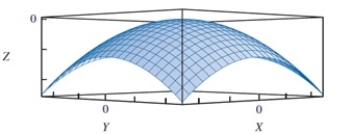
A)f(X, Y) = X2 + Y2
B)f(X, Y) = Xsin(2πY) + Ysin(2πX)
C)f(X, Y) = -X2 - Y2
D)f(X, Y) = Xsin(5πX) + Ysin(5πY)

A)f(X, Y) = X2 + Y2
B)f(X, Y) = Xsin(2πY) + Ysin(2πX)
C)f(X, Y) = -X2 - Y2
D)f(X, Y) = Xsin(5πX) + Ysin(5πY)

Unlock Deck
Unlock for access to all 46 flashcards in this deck.
Unlock Deck
k this deck
6
The reduced gradient is analogous to the __________ for linear models.
A)binary variable
B)binding constraint
C)reduced cost
D)objective coefficient
A)binary variable
B)binding constraint
C)reduced cost
D)objective coefficient

Unlock Deck
Unlock for access to all 46 flashcards in this deck.
Unlock Deck
k this deck
7
If all the squared terms in a quadratic function have a negative coefficient and there are no cross-product terms, then the function is a __________ function.
A)convex quadratic
B)nonlinear objective
C)concave quadratic
D)negative elliptical
A)convex quadratic
B)nonlinear objective
C)concave quadratic
D)negative elliptical

Unlock Deck
Unlock for access to all 46 flashcards in this deck.
Unlock Deck
k this deck
8
A feasible solution is a(n) __________ if there are no other feasible solutions with a better objective function value in the immediate neighborhood.
A)efficient frontier
B)local optimum
C)global maximum
D)diverging function
A)efficient frontier
B)local optimum
C)global maximum
D)diverging function

Unlock Deck
Unlock for access to all 46 flashcards in this deck.
Unlock Deck
k this deck
9
In a nonlinear optimization problem
A)the objective function is a nonlinear function of the constraints.
B)all the constraints are nonlinear only when the objective is to maximize the function of the decision variables.
C)at least one term in the objective function or a constraint is nonlinear.
D)both the objective function and the constraints must have all nonlinear terms.
A)the objective function is a nonlinear function of the constraints.
B)all the constraints are nonlinear only when the objective is to maximize the function of the decision variables.
C)at least one term in the objective function or a constraint is nonlinear.
D)both the objective function and the constraints must have all nonlinear terms.

Unlock Deck
Unlock for access to all 46 flashcards in this deck.
Unlock Deck
k this deck
10
A nonlinear function with at least one term raised to the power of two is known as a
A)hyperbolic function.
B)quadratic function.
C)logarithmic function.
D)cubic function.
A)hyperbolic function.
B)quadratic function.
C)logarithmic function.
D)cubic function.

Unlock Deck
Unlock for access to all 46 flashcards in this deck.
Unlock Deck
k this deck
11
A feasible solution is __________ if there are no other feasible points with a smaller objective function value in the entire feasible region.
A)a global minimum
B)not a local maximum
C)not a local minimum
D)bowl-shaped
A)a global minimum
B)not a local maximum
C)not a local minimum
D)bowl-shaped

Unlock Deck
Unlock for access to all 46 flashcards in this deck.
Unlock Deck
k this deck
12
In reviewing the image below, the point (0, 0, 0) is a(n) __________ for the given concave function. 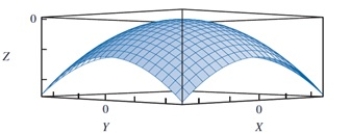
A)local maximum
B)local minimum
C)convergence point
D)endpoint

A)local maximum
B)local minimum
C)convergence point
D)endpoint

Unlock Deck
Unlock for access to all 46 flashcards in this deck.
Unlock Deck
k this deck
13
If there are no other feasible solutions with a larger objective function value in the immediate neighborhood, then the feasible solution is known as
A)a global maximum.
B)infeasible.
C)a nonlinear solution.
D)a local maximum.
A)a global maximum.
B)infeasible.
C)a nonlinear solution.
D)a local maximum.

Unlock Deck
Unlock for access to all 46 flashcards in this deck.
Unlock Deck
k this deck
14
A feasible solution is a local minimum if there are no other feasible solutions with a
A)smaller objective function value in the immediate neighborhood.
B)same objective function value in the immediate neighborhood.
C)set of points defining the minimum possible risk in the entire feasible region.
D)same objective function value in the entire feasible region.
A)smaller objective function value in the immediate neighborhood.
B)same objective function value in the immediate neighborhood.
C)set of points defining the minimum possible risk in the entire feasible region.
D)same objective function value in the entire feasible region.

Unlock Deck
Unlock for access to all 46 flashcards in this deck.
Unlock Deck
k this deck
15
A function that is bowl-shaped up is called a(n) _________ function.
A)concave
B)optimal
C)convex
D)elliptical
A)concave
B)optimal
C)convex
D)elliptical

Unlock Deck
Unlock for access to all 46 flashcards in this deck.
Unlock Deck
k this deck
16
If there are no other feasible points with a larger objective function value in the entire feasible region, a feasible solution is
A)an efficient frontier.
B)a global maximum.
C)not a local maximum.
D)a global minimum.
A)an efficient frontier.
B)a global maximum.
C)not a local maximum.
D)a global minimum.

Unlock Deck
Unlock for access to all 46 flashcards in this deck.
Unlock Deck
k this deck
17
In a nonlinear problem, the rate of change of the objective function with respect to the right-hand side of a constraint is given by the
A)slope of the contour line.
B)local optimum.
C)reduced gradient.
D)Lagrangian multiplier.
A)slope of the contour line.
B)local optimum.
C)reduced gradient.
D)Lagrangian multiplier.

Unlock Deck
Unlock for access to all 46 flashcards in this deck.
Unlock Deck
k this deck
18
A feasible solution is __________ if there are no other feasible points with a better objective function value in the entire feasible region.
A)infeasible
B)unbounded
C)nonlinear
D)a global optimum
A)infeasible
B)unbounded
C)nonlinear
D)a global optimum

Unlock Deck
Unlock for access to all 46 flashcards in this deck.
Unlock Deck
k this deck
19
A __________ is the shadow price of a binding simple lower or upper bound on the decision variable.
A)reduced gradient
B)binding constraint
C)binary variable
D)local optimum
A)reduced gradient
B)binding constraint
C)binary variable
D)local optimum

Unlock Deck
Unlock for access to all 46 flashcards in this deck.
Unlock Deck
k this deck
20
In reviewing the image below, which of the following functions is most likely to yield the above shape? 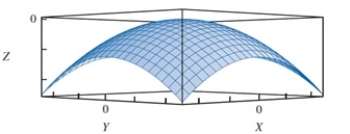
A)f(X, Y) = X2 + Y2
B)f(X, Y) = -X - Y
C)f(X, Y) = -X2 - Y2
D)f(X, Y) = Xsin(5πX) + Ysin(5πY)

A)f(X, Y) = X2 + Y2
B)f(X, Y) = -X - Y
C)f(X, Y) = -X2 - Y2
D)f(X, Y) = Xsin(5πX) + Ysin(5πY)

Unlock Deck
Unlock for access to all 46 flashcards in this deck.
Unlock Deck
k this deck
21
In the Bass forecasting model, the __________ measures the likelihood of adoption due to a potential adopter being influenced by someone who has already adopted the product.
A)coefficient of innovation
B)coefficient of imitation
C)coefficient of regression
D)coefficient of the objective function
A)coefficient of innovation
B)coefficient of imitation
C)coefficient of regression
D)coefficient of the objective function

Unlock Deck
Unlock for access to all 46 flashcards in this deck.
Unlock Deck
k this deck
22
In reviewing the image below, what is the minimum value for this function? 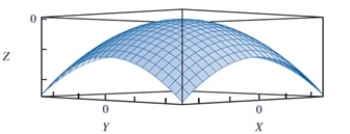
A)-8
B)0
C)-1
D)1

A)-8
B)0
C)-1
D)1

Unlock Deck
Unlock for access to all 46 flashcards in this deck.
Unlock Deck
k this deck
23
The measure of risk most often associated with the Markowitz portfolio model is the
A)expected return of the portfolio.
B)annual interest on the portfolio.
C)variance of the portfolio's return.
D)number of investments listed in the portfolio.
A)expected return of the portfolio.
B)annual interest on the portfolio.
C)variance of the portfolio's return.
D)number of investments listed in the portfolio.

Unlock Deck
Unlock for access to all 46 flashcards in this deck.
Unlock Deck
k this deck
24
Using the graph below, the feasible region for the function represented in the graph is 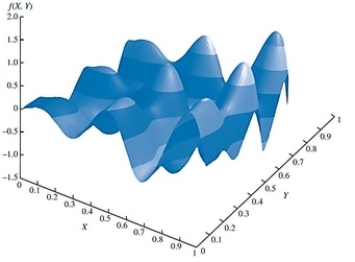
A)-1 £ X £ 1, -1 £ Y £ 1.
B)-1.5 £ X £ 1, 0 £ Y £ 8.
C)-1.5 £ X £ 2.0, -1.5 £ Y £ 2.0.
D)0 £ X £ 1, 0 £ Y £ 1.

A)-1 £ X £ 1, -1 £ Y £ 1.
B)-1.5 £ X £ 1, 0 £ Y £ 8.
C)-1.5 £ X £ 2.0, -1.5 £ Y £ 2.0.
D)0 £ X £ 1, 0 £ Y £ 1.

Unlock Deck
Unlock for access to all 46 flashcards in this deck.
Unlock Deck
k this deck
25
The __________ option in Excel Solver is helpful when the solution to a problem appears to depend on the starting values for the decision variables.
A)restart
B)convergence
C)derivatives
D)multistart
A)restart
B)convergence
C)derivatives
D)multistart

Unlock Deck
Unlock for access to all 46 flashcards in this deck.
Unlock Deck
k this deck
26
Using the graph below, which of the following is true of its function? 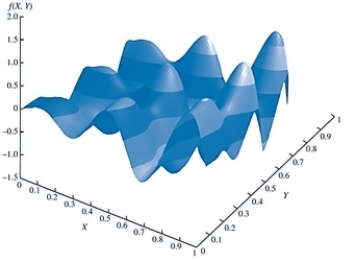
A)It has single local minimum.
B)It has multiple local optima.
C)It has single local maximum.
D)It has no maxima and minima.

A)It has single local minimum.
B)It has multiple local optima.
C)It has single local maximum.
D)It has no maxima and minima.

Unlock Deck
Unlock for access to all 46 flashcards in this deck.
Unlock Deck
k this deck
27
Which of the following conclusions can be drawn from the below figure using the Bass forecasting model? (Note: Bass forecasting model is given by: Ft = (p + q[Ct - 1 /m]) (m - Ct - 1)
Where m = the number of people estimated to eventually adopt the new product,
Ct - 1 = the number of people who have adopted the product through time t - 1,
Q = the coefficient of imitation, and
P = the coefficient of innovation.![<strong>Which of the following conclusions can be drawn from the below figure using the Bass forecasting model? (Note: Bass forecasting model is given by: F<sub>t</sub> = (p + q[Ct<sub> - 1</sub> /m]) (m - Ct<sub> - 1</sub>) Where m = the number of people estimated to eventually adopt the new product, Ct<sub> - 1</sub> = the number of people who have adopted the product through time t - 1, Q = the coefficient of imitation, and P = the coefficient of innovation. </strong> A)q < p B)q > p C)m < q D)p > m](https://d2lvgg3v3hfg70.cloudfront.net/TB1188/11eb0d2f_b222_0580_9790_7366b4e30ad4_TB1188_00.jpg)
A)q < p
B)q > p
C)m < q
D)p > m
Where m = the number of people estimated to eventually adopt the new product,
Ct - 1 = the number of people who have adopted the product through time t - 1,
Q = the coefficient of imitation, and
P = the coefficient of innovation.
![<strong>Which of the following conclusions can be drawn from the below figure using the Bass forecasting model? (Note: Bass forecasting model is given by: F<sub>t</sub> = (p + q[Ct<sub> - 1</sub> /m]) (m - Ct<sub> - 1</sub>) Where m = the number of people estimated to eventually adopt the new product, Ct<sub> - 1</sub> = the number of people who have adopted the product through time t - 1, Q = the coefficient of imitation, and P = the coefficient of innovation. </strong> A)q < p B)q > p C)m < q D)p > m](https://d2lvgg3v3hfg70.cloudfront.net/TB1188/11eb0d2f_b222_0580_9790_7366b4e30ad4_TB1188_00.jpg)
A)q < p
B)q > p
C)m < q
D)p > m

Unlock Deck
Unlock for access to all 46 flashcards in this deck.
Unlock Deck
k this deck
28
A(n) __________ is a set of points defining the minimum possible risk for a set of return values.
A)contour
B)efficient frontier
C)unity constraint
D)reduced gradient
A)contour
B)efficient frontier
C)unity constraint
D)reduced gradient

Unlock Deck
Unlock for access to all 46 flashcards in this deck.
Unlock Deck
k this deck
29
In the Bass forecasting model, the ___________ measures the likelihood of adoption, assuming no influence from someone who has already purchased (adopted) the product.
A)coefficient of correlation
B)coefficient of imitation
C)coefficient of independence
A)coefficient of correlation
B)coefficient of imitation
C)coefficient of independence

Unlock Deck
Unlock for access to all 46 flashcards in this deck.
Unlock Deck
k this deck
30
One of the ways to use the Bass forecasting model is to wait until several periods of data for the problem under consideration are available. This is known as the ___________ approach.
A)branch-and-bound
B)cutting plane
C)rolling-horizon
D)sensible-period
A)branch-and-bound
B)cutting plane
C)rolling-horizon
D)sensible-period

Unlock Deck
Unlock for access to all 46 flashcards in this deck.
Unlock Deck
k this deck
31
The __________ forecasting model uses nonlinear optimization to forecast the adoption of innovative and new technologies in the marketplace.
A)Hauck
B)LMS
C)Markowitz
D)Bass
A)Hauck
B)LMS
C)Markowitz
D)Bass

Unlock Deck
Unlock for access to all 46 flashcards in this deck.
Unlock Deck
k this deck
32
The portfolio variance is the
A)sum of the squares of the deviations from the mean value under each scenario.
B)average of the sum of the squares of the deviations from the mean value under each investment scenario.
C)average of the product of the squares of the deviations from the mean value under each scenario.
D)average of the sum of the deviations from the mean value under each investment scenario.
A)sum of the squares of the deviations from the mean value under each scenario.
B)average of the sum of the squares of the deviations from the mean value under each investment scenario.
C)average of the product of the squares of the deviations from the mean value under each scenario.
D)average of the sum of the deviations from the mean value under each investment scenario.

Unlock Deck
Unlock for access to all 46 flashcards in this deck.
Unlock Deck
k this deck
33
If the portfolio variance were equal to zero, the amount of risk would be
A)unity.
B)a positive number greater than 1.
C)negative always.
D)zero.
A)unity.
B)a positive number greater than 1.
C)negative always.
D)zero.

Unlock Deck
Unlock for access to all 46 flashcards in this deck.
Unlock Deck
k this deck
34
Using the graph given below, which of the following equations represents the function shown in the graph? 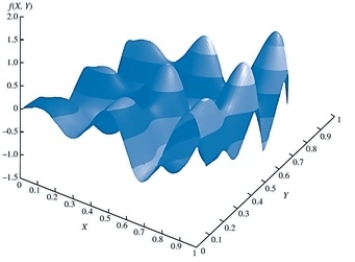
A)f(X, Y) = Xlog(2πY) + Ylog(2πX)
B)f(X, Y) = X - Y
C)f(X, Y) = -X2 - Y2
D)f(X, Y) = Xsin(5πX) + Ysin(5πY)

A)f(X, Y) = Xlog(2πY) + Ylog(2πX)
B)f(X, Y) = X - Y
C)f(X, Y) = -X2 - Y2
D)f(X, Y) = Xsin(5πX) + Ysin(5πY)

Unlock Deck
Unlock for access to all 46 flashcards in this deck.
Unlock Deck
k this deck
35
A portfolio optimization model used to construct a portfolio that minimizes risk subject to a constraint requiring a minimum level of return is known as
A)a capital budgeting pricing model.
B)a market share optimization model.
C)the Hauck maximum variance portfolio model.
D)the Markowitz mean-variance portfolio model.
A)a capital budgeting pricing model.
B)a market share optimization model.
C)the Hauck maximum variance portfolio model.
D)the Markowitz mean-variance portfolio model.

Unlock Deck
Unlock for access to all 46 flashcards in this deck.
Unlock Deck
k this deck
36
Solving nonlinear problems with local optimal solutions is performed using _____________, in Excel Solver, which is based on more classical optimization techniques.
A)Goal Seeker
B)Linear Regression
C)GRG Nonlinear
D)Simplex LP
A)Goal Seeker
B)Linear Regression
C)GRG Nonlinear
D)Simplex LP

Unlock Deck
Unlock for access to all 46 flashcards in this deck.
Unlock Deck
k this deck
37
Which of the following is a second way of formulating the Markowitz model?
A)Maximize the expected return of the portfolio subject to a constraint on variance.
B)Minimize the expected return of the portfolio subject to a constraint on variance.
C)Maximize the variance of the portfolio subject to a constraint on the expected return of the portfolio.
D)Maximize the variance of the portfolio with no constraint needed for the expected return of the portfolio.
A)Maximize the expected return of the portfolio subject to a constraint on variance.
B)Minimize the expected return of the portfolio subject to a constraint on variance.
C)Maximize the variance of the portfolio subject to a constraint on the expected return of the portfolio.
D)Maximize the variance of the portfolio with no constraint needed for the expected return of the portfolio.

Unlock Deck
Unlock for access to all 46 flashcards in this deck.
Unlock Deck
k this deck
38
In the Bass forecasting model, parameter m
A)measures the likelihood of adoption due to a potential adopter being influenced by someone who has already adopted the product.
B)measures the likelihood of adoption, assuming no influence from someone who has already adopted the product.
C)refers to the number of people estimated to eventually adopt the new product.
D)refers to the number of people who have already adopted the new product.
A)measures the likelihood of adoption due to a potential adopter being influenced by someone who has already adopted the product.
B)measures the likelihood of adoption, assuming no influence from someone who has already adopted the product.
C)refers to the number of people estimated to eventually adopt the new product.
D)refers to the number of people who have already adopted the new product.

Unlock Deck
Unlock for access to all 46 flashcards in this deck.
Unlock Deck
k this deck
39
Excel Solver's __________ is based on a method that searches for an optimal solution by iteratively adjusting a population of candidate solutions.
A)Evolutionary Solver
B)Goal Seeker
C)Simplex LP
D)GRG Nonlinear
A)Evolutionary Solver
B)Goal Seeker
C)Simplex LP
D)GRG Nonlinear

Unlock Deck
Unlock for access to all 46 flashcards in this deck.
Unlock Deck
k this deck
40
One of the ways to formulate the Markowitz model is to
A)maximize the variance of the portfolio subject to a constraint on the expected return of the portfolio.
B)minimize the expected return of the portfolio subject to a constraint on variance.
C)minimize the variance of the portfolio subject to a constraint on the expected return of the portfolio.
D)minimize the expected return of the portfolio with no constraint on variance.
A)maximize the variance of the portfolio subject to a constraint on the expected return of the portfolio.
B)minimize the expected return of the portfolio subject to a constraint on variance.
C)minimize the variance of the portfolio subject to a constraint on the expected return of the portfolio.
D)minimize the expected return of the portfolio with no constraint on variance.

Unlock Deck
Unlock for access to all 46 flashcards in this deck.
Unlock Deck
k this deck
41
If an optimization objective function produces a graph that is concave, will the global optimum be a maximum or minimum value? Explain.

Unlock Deck
Unlock for access to all 46 flashcards in this deck.
Unlock Deck
k this deck
42
If an optimization objective function produces a graph that is convex, how many local minimum solutions are possible? Explain.

Unlock Deck
Unlock for access to all 46 flashcards in this deck.
Unlock Deck
k this deck
43
An Electrical Company has two manufacturing plants. The cost in dollars of producing an Amplifier at each of the two plants is given below. The cost of producing Q1 Amplifiers at the first plant is:
65Q1 + 4Q12+ 90
and the cost of producing Q2 Amplifiers at the second plant is:
20Q2 + 2Q22+ 120
The company needs to manufacture at least 60 Amplifiers to meet the received orders. How many Amplifiers should be produced at each of the plants to minimize the total production cost? Round the answers to two decimal places and the total cost to the nearest dollar value.
65Q1 + 4Q12+ 90
and the cost of producing Q2 Amplifiers at the second plant is:
20Q2 + 2Q22+ 120
The company needs to manufacture at least 60 Amplifiers to meet the received orders. How many Amplifiers should be produced at each of the plants to minimize the total production cost? Round the answers to two decimal places and the total cost to the nearest dollar value.

Unlock Deck
Unlock for access to all 46 flashcards in this deck.
Unlock Deck
k this deck
44
Is a location optimization problem an example of a maximization or a minimization problem? Explain.

Unlock Deck
Unlock for access to all 46 flashcards in this deck.
Unlock Deck
k this deck
45
If a maximization problem has a single global optimum, will it have a local maximum? If yes, can it have more than one local maximum? Explain.

Unlock Deck
Unlock for access to all 46 flashcards in this deck.
Unlock Deck
k this deck
46
If a minimization problem has a single global optimum, will it have a local minimum? If yes, can it have more than one local minimum? Explain.

Unlock Deck
Unlock for access to all 46 flashcards in this deck.
Unlock Deck
k this deck



